What does the rainbow flag mean and why is it a symbol for Pride today?
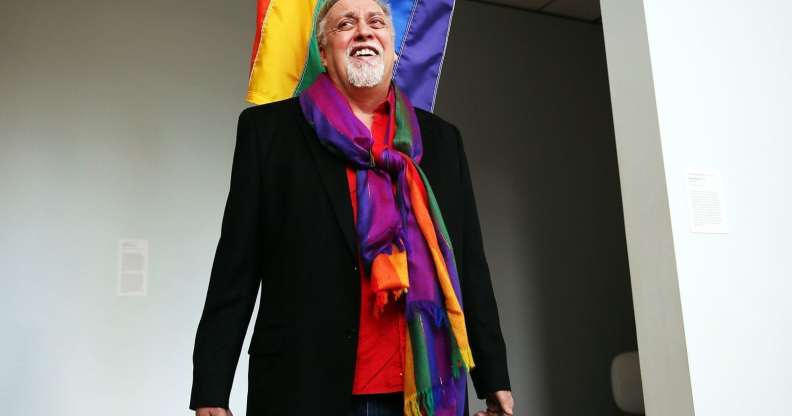
NEW YORK, NY – JANUARY 07: Rainbow Flag Creator Gilbert Baker poses at the Museum of Modern Art (MoMA) on January 7, 2016 in New York City. MoMa announced in June 2015 its acquisition of the iconic Rainbow Flag into the design collection. Baker, an openly gay artist and civil rights activist, designed the Rainbow Flag in 1978. The flag has since become a prominent symbol to the gay community around the world. (Photo by Spencer Platt/Getty Images)
NEW YORK, NY - JANUARY 07: Rainbow Flag Creator Gilbert Baker poses at the Museum of Modern Art (MoMA) on January 7, 2016 in New York City. MoMa announced in June 2015 its acquisition of the iconic Rainbow Flag into the design collection. Baker, an openly gay artist and civil rights activist, designed the Rainbow Flag in 1978. The flag has since become a prominent symbol to the gay community around the world. (Photo by Spencer Platt/Getty Images)
There’s rainbows, rainbows everywhere.
No matter whether they’re pinned to an underside of a bag, displayed in a shop window, or painted onto some glamourpusses cheek, we cannot escape the rainbow symbol if we even wanted to.
In some areas of the globe, we are so awash with rainbow flags right now the high street feels like a less ominous scene from Alfred Hitchcock’s Birds.
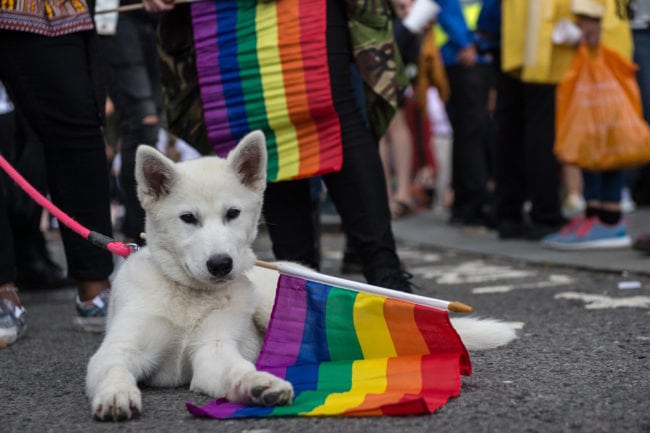
Shiro, a Siberian Husky, plays with a rainbow flag as the LGBT community celebrates Pride in London (Chris J Ratcliffe/Getty)
But as we grow that little bit more concerned about the rampant commercialisation of the rainbow symbol and its purpose, we want to answer a few pressing questions: where did the rainbow come from, and has it stood the test of time?
How did the rainbow SYMBOL first come into existence?
Before he was assassinated later on in the year, gay politician Harvey Milk asked a talented gay designed her knew to design an all-encompassing symbol to take on San Francisco’s Pride March in 1978.

Milk asked for a gay designer and activist to make the flag (Getty)
Who designed THE RAINBOW SYMBOL?
The designer who Milk asked was a gay man named Gilbert Baker. Self-described as a “gay Betsy Ross,” activist Baker was one of the original Pride marchers in the US as well as a print designer.
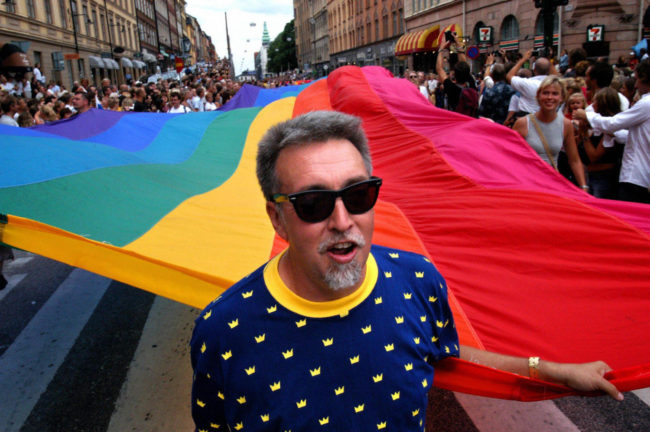
Gilbert Baker, who designed the most internationally known symbol for the gay culture, the rainbow flag, 25 years ago, heads the Stockholm Pride Parade carrying a 250-metre long flag in Stockholm (FREDRIK PERSSON/AFP/Getty Images)
Why the rainbow on the pride flag?
The print designer got the idea for the rainbow symbol when he was dancing in a gay bar and high on LSD with his friend. It was after that he asked his friends to help him hand-dye and stitch together the eight colours for the pride flag.
Prior to the rainbow symbol, the most recognisable queer symbol was the pink triangle – and because Adolf Hitler conceived the pink triangle, Baker and Milk believed it was time to distance the community from its pain.
“[The pink triangle] represented a dark chapter in the history of same-sex rights,” Baker wrote in his memoir.
“Adolph Hitler conceived the pink triangle during World War II as a stigma placed on homosexuals in the same way the Star of David was used against Jews. It functioned as a Nazi tool of oppression,” he wrote in his memoir. “We all felt that we needed something that was positive, that celebrated our love.”
The colours represented different elements of a gay person’s life: pink for sex, red for life, orange for healing, yellow for sun, green for nature, turquoise for magic, blue for peace and purple for spirit.
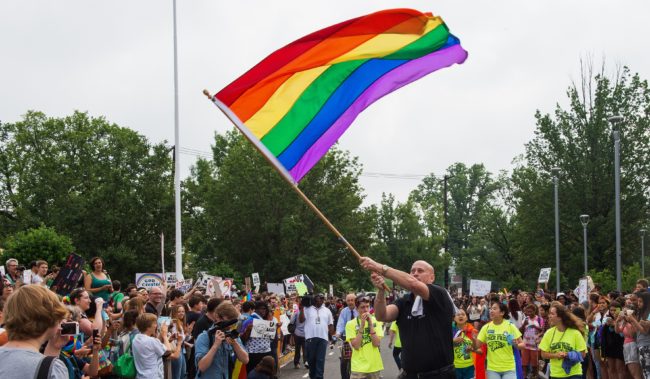
Canada’s Supreme Court ruling is being praised by LGBT rights campaigners. (Getty)
The pink and the turquoise were eventually dropped from the design because they were too costly for printers to reproduce.
Has the rainbow flag stood the test of time?
Although Baker died last year, his rainbow-filled legacy lives on.
In deciding to not copyright the rainbow design, he allowed the LGBT+ community around the world to use it to share their pride in their identity.
As the movement has diversified in recent years — the likes of the trans, non-binary and asexual communities are now acknowledged and recognised — some members of the community wish for a more diverse flag to represent them.
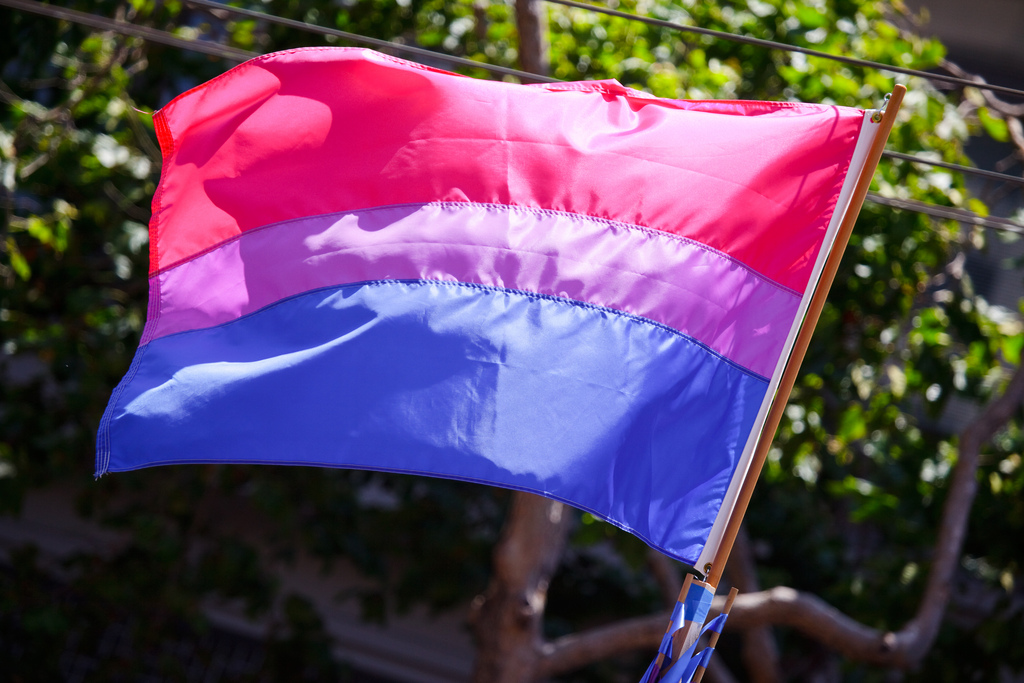
The bisexual pride flag (Getty)
A diverse roster of flags have come into fruition for separate strands of the community.
Whether flag wavers are bisexual, asexual or intersex, these flags may be preferred by those who accuse companies of “pinkwashing” their businesses with the rainbow symbol to profit from the pink pound.
Daniel Quasar, who identifies as queer and non-binary, has made-over the six-coloured rainbow flag.
He added a five-striped arrow to the design reflect “all aspects of our community.”
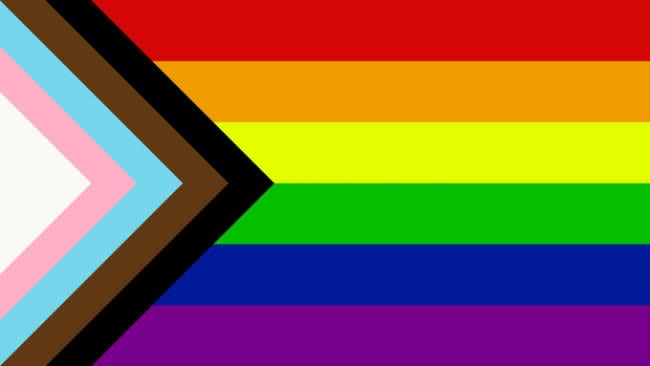
Graphic designer Daniel Quasar’s re-booted Pride flag (Kickstarter)
The designer added black and brown stripes to the top of the Pride flag so as to include LGBT people of colour.
The white, pink, and light blue colours reflect those of the transgender Pride flag, which was designed by Monica Helms in 1999.
Although the flag achieved its goal on Kickstarter, it has received mixed reviews from LGBT+ people as a whole.
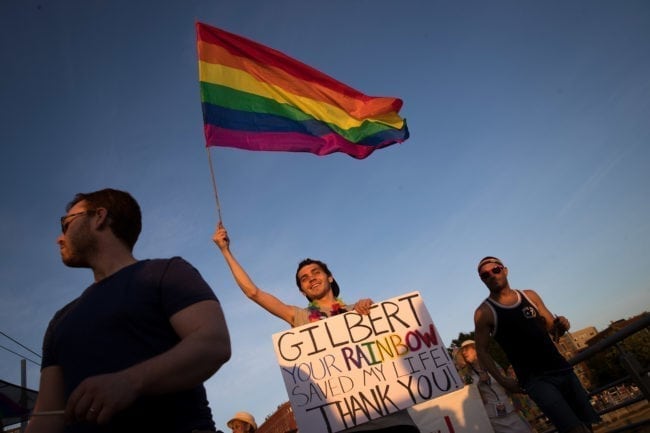
Participants march during a Flag Day ‘Raise the Rainbow’ rally, June 14, 2017 in New York City. The event honored LGBT rainbow flag creator Gilbert Baker, who died in March 2017. (Photo by Drew Angerer/Getty Images)
Whatever colour flag you choose, it’s good to know that there are more representations available than ever to symbolise the diverse, vibrant roster of people who consider themselves to be LGBT+ today.

